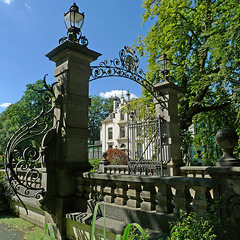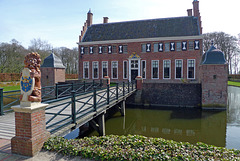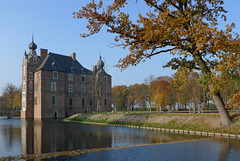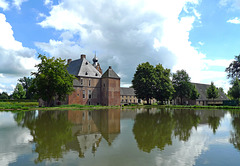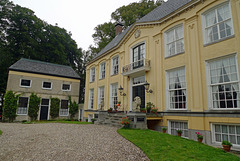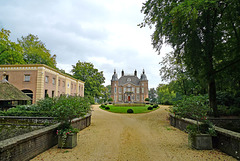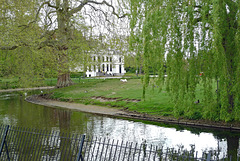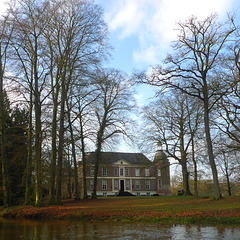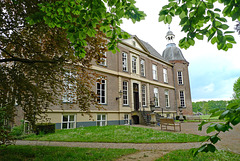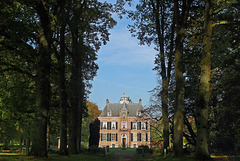
Nederland: kastelen en buitenplaatsen
Folder: Nederland - the Netherlands
Foto's van Nederlandse kastelen, landhuizen, havezathe's en buitenplaatsen.
Nederland - Staverden
| |
|
|
|
Around the year of 1300 Count Reinald van Gelre founded a settlement on the northern Veluwe. The ‘village’ was given city rights in 1298 as a form of encouragement and as a reward for his ambitions. But the development of Staverden never happened and there has never been any urban development since. It never came to anything more than the castle. Staverden Estate however does have 16 farms spread across its lands; a coach house, orangery, watermill, dovecot, workers' houses, a church and a cemetery, and is officially the smallest city in the Netherlands and the Benelux with its ca. 50 inhabitants (situation 2018).
The castle was frequently used as a hunting lodge by the Dukes of Gelre. Since 1400 there were feudal lords living at castle Staverden, who had to preserve and defend the castle. Around 1600 the castle was owned by the Van Haersoltes , who rebuilt it into a more habitable house.
Around 1840 the manor was rebuilt again; Staverden Castle got its current form in 1905, after the estate was purchased by Frederik Bernard s’Jacob , former mayor of Rotterdam. His heirs sold the house to the current owner, the foundation Geldersch Landschap en Kasteelen .
(Picture from another season: www.ipernity.com/doc/294067/21893815)
Nederland - Twello, Huize Kruisvoorde
| |
|
|
|
Huize Kruisvoorde is a monumental country house. Part of this former ‘havezate’ (manorial farm) dates from the 16th century. The building is also known as Crusefort , Cruystenvoorde or Cruysvoorde . The name probably refers to a voorde , a ford at a crossing of the trade route to Deventer and the dug waterway Terwoldse Wetering .
Huize Kruisvoorde was looted in 1572, during the Eighty Years' War. In the 18th century, a front wing was added to the building. A century later, the manor was given a coat of plaster, but this was removed at the beginning of the 20th century. An imposing square tower was then added to the building.
Huize Kruisvoorde - like nearby De Parckelaer - became a Dutch heritage site in 1971. Nowadays, the country house is privately owned.
Nederland - Twello, De Parckelaer
| |
|
|
|
Originally De Parckelaer was a so called havezate (manorial farm). The oldest mention of the house dates from 1434. Just like the nearby Kruisvoorde manor house, the building belonged to the Van Mermuden family. Later, the manor came into the possession of the Van Essen and Van Reede families, important noblemen on the Veluwe.
The present building dates from the end of the 17th century or the beginning of the 18th century. In 1843, the building became the property of the commissioner Jacob Roeters van Lennep. Commissioned by his son the building was given a new frontage in 1868. The entrance was also provided with a cast-iron roof with a balcony on the first floor.
At the end of the 19th century, the house was empty and fell into disrepair. Fortunately, the Parckelaer's demolition was prevented. In 1990 and the following years, the building was restored. De Parckelaer became a national Dutch heritage site in 1991. The estate is still privately owned and not open to the public.
Nederland - Uithuizen, Menkemaborg
| |
|
|
|
The Menkemaborg* in Uithuizen is a 14th-century, brick-built country house, which was substantially altered around 1700; since then it has since barely been changed. Nowadays, being part of a museum, the borg is open for public.
*In the Dutch province of Groningen a 'borg' is a former stronghold or estate house, surrounded by moats and gardens.
Nederland - Vaassen, Kasteel De Cannenburch
| |
|
|
|
Kasteel De Cannenburch/Castle 'De Cannenburch" is a 16th-century castle in Vaassen in the province of Gelderland.
The castle seen from the east surrounded by ponds and a moat.
Nederland - Vaassen, Kasteel De Cannenburgh
| |
|
|
|
Cannenburgh Castle was built in 1543 by a famous Dutch figure, Marten van Rossem. He constructed a country house on the spot of a medieval castle.
In the Middle Ages the village of Vaassen had a castle, called Kannenberg, but its not kwon when it was built. The first records date from 1365 and at that point in history, it was a leasehold estate belonging to the dukes of Guelders. The ruins of fortress were bought in 1543 by Marten van Rossem. He chose the style of the Dutch Renaissance for Cannenburgh Castle and built it on top of the remains of the old stronghold. However, he never managed to see the castle completed.
Van Rossem died in 1555 and his nephew, Hendrik van Isendoorn, inherited the castle and it remained in the family for over three centuries. Over the years, the castle has been altered and extended many times and it became also a stone entrance bridge.
Since the 1950’s Cannenburgh Castle and surrounding park are owned and managed by the ‘Stichting Geldersch Landschap en Geldersche Kasteelen’, a Dutch heritage foundation; castle and park are open for visitors.
Nederland - Vaassen, Kasteel De Cannenburgh
| |
|
|
|
Cannenburgh Castle was built in 1543 by a famous Dutch figure, Marten van Rossem. He constructed a country house on the spot of a medieval castle.
In the Middle Ages the village of Vaassen had a castle, called Kannenberg, but its not kwon when it was built. The first records date from 1365 and at that point in history, it was a leasehold estate belonging to the dukes of Guelders. The ruins of fortress were bought in 1543 by Marten van Rossem. He chose the style of the Dutch Renaissance for Cannenburgh Castle and built it on top of the remains of the old stronghold. However, he never managed to see the castle completed.
Van Rossem died in 1555 and his nephew, Hendrik van Isendoorn, inherited the castle and it remained in the family for over three centuries. Over the years, the castle has been altered and extended many times and it became also a stone entrance bridge.
Since the 1950’s Cannenburgh Castle and surrounding park are owned and managed by the ‘Stichting Geldersch Landschap en Geldersche Kasteelen’, a Dutch heritage foundation; castle and park are open for visitors.
Nederland - Veenklooster, Fogelsangh State
| |
|
|
|
Fogelsangh State is built on the site where in the 12th century a monastery (Olijfberg – Mount of Olives) has stand. At the time of the Reformation (1580) the monastery, like all church property, was confiscated and ownership became to the Council of Friesland. In 1639 the building was bought by Theodorus van Fogelsangh and in 1646 it went to his brother Pibo, who named himself after his mother, Doma.
In the 18th and 19th century the house was rebuilt several times, the last restoration dates from 2001 to 2003. Since its construction in 1646 the country estate is still private owned through inheritance by a member of the Harinxma thoe Slooten family.
Fogelsangh State nowadays is a museum (part of the Friesland Museum) and houses, among other exhibits, the quite famous ‘Iddekinge porcelain collection’.
Nederland - Veenwouden, Schierstins
| |
|
|
|
The 'Schierstins' in Veenwouden is a medieval 'Stienhús' (stone house) built around the year of 1300 out of brick and is the only remaining 'Stienhús' in Friesland.
The 'Schierstins' was first mentioned in 1439 on a piece of parchment.
Nederland - Velp, Kasteel Biljoen
| |
|
|
|
Kasteel Biljoen , originally called Broekerhof , was a place were taxes were collected. It was first mentioned in 1076 as it was a large farm, which was donated to the chapter of St. Peter in Utrecht by Emperor Heinrich IV. Around the year of 1530 Duke Karel van Gelder built the first Noble House, partly with materials from the nearby Kasteel Overhagen .
In 1535, the Duke of Gelre sold the castle due to a lack of money. It had various owners until it came into the possession of Alexander van Spaen in 1661. He rebuilt the house into the present day castle with four equal corner towers, each crowned by a helmet-shaped roof. The family Van Spaen rebuilt the castle again in the the 18th century.
In 1795 French troops were quartered in the castle. After they left the castle was plundered and the interior largely destroyed. In 1849 baron Van Hardenbroek allowed Anna Pavlovna of Russia to use it temporarily. In 1872 it was inherited by the family Lüps, until 2008. Today (2021) Kasteel Biljoen is owned by an American family and the castle itself is closed off to public visits.
Nederland: Velsen-Zuid, Buitenplaats Beeckestijn
| |
|
|
|
Beeckestijn is an 18th century estate and one of the few entirely intact large country houses, which was created as summer residences for wealthy Amsterdam regents on the edge of the dunes in Kennemerland. The present building was created from a 17th century manor and had several alterations and extensions.
The most extensive expansion took place between 1716 and 1721, commissioned by Jan Trip jr. and Petronella van Hoorn. Among other things the 17th century façade was replaced by a Louis-XIV façade, with chequered pilasters and a richly decorated entrance.
For more than two centuries Beeckestijn remained in the ownership of the Boreel family, until it was acquired by the municipality of Velsen in 1952. During WW II the house was seriously damaged. It became uninhabitable and key interior elements disappeared; the restoration was completed in 1969.
The publicly accessible gardens of Beeckestijn are unique in the Netherlands, because it is the only location where one can simultaneously view two historically different styles. Just behind the manor a geometrically conceived part in the style of the French Baroque and adjacent a more natural English landscape park.
The manor is now owned by ‘Vereniging Hendrick de Keyser’ - an association for the preservation of historic houses in the Netherlands - and the garden and park by ‘Natuurmonumenten’ - a society for preservation of nature monuments in the Netherlands.
Nederland: Velsen-Zuid, Buitenplaat Beeckestijn
| |
|
|
|
Buitenplaats Beeckestijn (summer residence Beeckestijn) is an 18th century estate and one of the few entirely intact large country houses, which was created as summer residences for wealthy Amsterdam merchants and regents on the edge of the dunes in Kennemerland. The present building was created from a 17th century manor and had several alterations and extensions.
The most extensive expansion took place between 1716 and 1721, commissioned by Jan Trip jr. and Petronella van Hoorn. Among other things the 17th century façade was replaced by a Louis-XIV façade, with chequered pilasters and a richly decorated entrance.
For more than two centuries Beeckestijn remained in the ownership of the Boreel family, until it was acquired by the municipality of Velsen in 1952. During WW II the house was seriously damaged. It became uninhabitable and key interior elements disappeared; the restoration was completed in 1969.
The manor is now owned and managed by ‘Vereniging Hendrick de Keyser’ - an association for the preservation of historic houses in the Netherlands. Since June 2019 Buitenplaats Beeckestijn is a museum, where one can experience the atmosphere in which the rich merchants of Amsterdam used to live.
Nederland: Velsen-Zuid, Buitenplaats Velserbeek
| |
|
|
|
Velserbeek is one of the many so called buitenplaatsen (summer residences) west of the city of Haarlem along the inner dunes. Wealthy merchants from Amsterdam built their mansionsin the 16th and 17th centuries.
Buitenplaats Velserbeek is dating back to jaar 1544. Originally it was a farmhouse, owned by the regent-family Ramp who lived in nearby Overveen and held governmental positions in Haarlem. In 1639, the homestead was sold to the wealthy Amsterdam merchant Jerimias van Keulen. Van Keulen was very wealthy and had a family of 15 children. He had the homestead extended into a country estate with the present mansion and ornamental gardens. The park was laid out in the French.
In the years that followed, Velserbeek had several different owners. From 1781 it was owned by the members of the Goll van Franckenstein family. Until 1832 Velserbeek remained in the possession of this family. The heirs sold the Velserbeek country house to the Van Tuyll van Serooskerken family. Baron Ernst van Tuyll almost immediately commissioned changes to the garden layout. The most important change is the creation of a deer park in front of the mansion, which nowadays still exists.
In 1919 Velserbeek was sold to two entrepreneurs, who want to convert the main building into a factory. Eventually, the municipality of Velsen buys the estate: the most beautiful part became a public park, while another part is destined for the construction of villas.
Since 1995, Buitenplaats Velserbeek has been owned by a law firm, which has restored the house.
Nederland - Vogelenzang, Huis Leyduin
| |
|
|
|
For wealthy city inhabitants in the western part of the Netherlands, owning a country house increasingly became a status symbol. At the beginning of the 19th century, there were more than 120 of them between Beverwijk and Hillegom along the inner dunes.
One of them was Huis Leyduin , which was already mentioned as a homestead in 1596. The estate was increasingly expanded by the owners. In the 18th century, the place was inhabited by the Van Loon family. They built a belvedere, which stand on a man made hill and had lines of sight across the area in the past.
In the year of 1808 Leyduin came into the possession of the Van Lennep family. They had a new house built on the site of the old mansion and also made parts of the country estate available for the first dune water extraction, intended for the city of Amsterdam.
The current Huis Leyduin was built in 1921 and was inhabited by the Dorhout Mees family.
After the World War II, Huis Leyduin was a girls' boarding school and a training institute, among other things. Since 1997, Leyduijn has been owned by Landschap Noord Holland (a Dutch foundation which aims to protect the landscape and nature of the province of North Holland).
The house itself is not open for public, but the surrounding park is free to visit. Nowadays the estate is a Dutch national monument.
Nederland - Kasteel Vorden
| |
|
|
|
Castle Vorden was first mentioned in a deed from 1315, in which ‘Steven van Vorden’ the castle and outbuildings gave to his uncle, Dirk van Vorden.
The castle probably dates from the 13th century, but it was very different from today. The square tower was certainly part of the medieval building, but the present castle for the most part was built in the 16th century. This square shape was then common. The castle lost in the course of centuries its defensive function and was rebuilt in the 19th century into a mansion. In 1873, the entrance was moved to the northern wing, with a wooden bridge across the moat.
The castle was left to decay after the World War II until restoration took place in 1976 and it became city hall of the municipality of Vorden. In 2004 Castle Vorden was sold to a private invester, who restored the house to its former glory. Since then the castle is used as a wedding venue and hotel.
Castle Vorden is one of the eight castles/mansions in and a round Vorden. There is a special bike route along these castles.
Nederland - Vorden, Kasteel Hackfort
| |
|
|
|
The history of Hackfort Castle is dating back to the year of 1322, when it was officially mentioned. In 1392 ‘House Hacforden’ was nothing more than just a residential tower. In the 1586 the castle was destroyed by the Spanish troops during the Eighty Year's War (the Dutch Independent War). After the liberation of the region by Prince Maurits van Oranje, the castle was rebuilt in 1598 by Borchard van Westerholt.
In 1788, Hackfort Castle underwent substantial renovations. The old gate house and outbuildings were demolished and the canals were filled in. The castle was transformed into an 18th-century manor house. Nowadays only the two thick cylindrical towers are reminders of the (former) castle.
The castle remained for centuries in the possession of the family Van Westerholt. When the last Baroness Westerholt of Hackfort died in1981, Hackfort Castle and estate were donated to Natuurmonumenten (Netherlands Natural Heritage Society) and the house, coachhouse (nowadays a restaurant) and watermill have since been restored and opened to the public, although with limited opening hours.
The picture is taken from the watermill: www.ipernity.com/doc/294067/26902929/in/album/537909
Nederland - Vorden, Kasteel Hackfort
| |
|
|
|
The history of Hackfort Castle is dating back to the year of 1322, when it was officially mentioned. In 1392 ‘House Hacforden’ was nothing more than just a residential tower. In the 1586 the castle was destroyed by the Spanish troops during the Eighty Year's War (the Dutch Independent War). After the liberation of the region by Prince Maurits van Oranje, the castle was rebuilt in 1598 by Borchard van Westerholt.
In 1788, Hackfort Castle underwent substantial renovations. The old gate house and outbuildings were demolished and the canals were filled in. The castle was transformed into an 18th-century manor house. Nowadays only the two thick cylindrical towers are reminders of the (former) castle. The castle is surrounded by forests and meadows and includes the watermill of Hackfort.
The castle remained for centuries in the possession of the family Van Westerholt. When the last Baroness Westerholt of Hackfort died in1981, Hackfort Castle and estate were donated to Natuurmonumenten (Netherlands Natural Heritage Society). The house, coachhouse (nowadays a restaurant) and watermill have since been restored and opened to the public.
Nederland - Vorden, Den Bramel
| |
|
|
|
Den Bramel is one of the eight castles in and around the small village of Vorden. The history of Den Bramel is dating back to the year of 1396, when it was first mentioned. The present manor was built from 1720 – 1726 and a couple of times renovated and extended. The ‘castle’ is still privately owned and inhabited.
The so called Achtkastelenroute (Eight Castles Route) is a special bike route along the castles.
Jump to top
RSS feed- Latest items - Subscribe to the latest items added to this album
- ipernity © 2007-2024
- Help & Contact
|
Club news
|
About ipernity
|
History |
ipernity Club & Prices |
Guide of good conduct
Donate | Group guidelines | Privacy policy | Terms of use | Statutes | In memoria -
Facebook
Twitter

